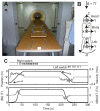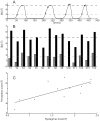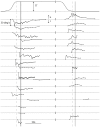On the vertigo due to static magnetic fields
- PMID: 24205304
- PMCID: PMC3813712
- DOI: 10.1371/journal.pone.0078748
On the vertigo due to static magnetic fields
Abstract
Vertigo is sometimes experienced in and around MRI scanners. Mechanisms involving stimulation of the vestibular system by movement in magnetic fields or magnetic field spatial gradients have been proposed. However, it was recently shown that vestibular-dependent ocular nystagmus is evoked when stationary in homogenous static magnetic fields. The proposed mechanism involves Lorentz forces acting on endolymph to deflect semicircular canal (SCC) cupulae. To investigate whether vertigo arises from a similar mechanism we recorded qualitative and quantitative aspects of vertigo and 2D eye movements from supine healthy adults (n = 25) deprived of vision while pushed into the 7T static field of an MRI scanner. Exposures were variable and included up to 135s stationary at 7T. Nystagmus was mainly horizontal, persisted during long-exposures with partial decline, and reversed upon withdrawal. The dominant vertiginous perception with the head facing up was rotation in the horizontal plane (85% incidence) with a consistent direction across participants. With the head turned 90 degrees in yaw the perception did not transform into equivalent vertical plane rotation, indicating a context-dependency of the perception. During long exposures, illusory rotation lasted on average 50 s, including 42 s whilst stationary at 7T. Upon withdrawal, perception re-emerged and reversed, lasting on average 30 s. Onset fields for nystagmus and perception were significantly correlated (p<.05). Although perception did not persist as long as nystagmus, this is a known feature of continuous SSC stimulation. These observations, and others in the paper, are compatible with magnetic-field evoked-vertigo and nystagmus sharing a common mechanism. With this interpretation, response decay and reversal upon withdrawal from the field, are due to adaptation to continuous vestibular input. Although the study does not entirely exclude the possibility of mechanisms involving transient vestibular stimulation during movement in and out of the bore, we argue these are less likely.
Conflict of interest statement
Figures





References
-
- Schenck JF, Dumoulin CL, Redington RW, Kressel HY, Elliott RT, et al. (1992) Human exposure to 4.0-Tesla magnetic fields in a whole-body scanner. Med Phys 19: 1089–1098. - PubMed
Publication types
MeSH terms
LinkOut - more resources
Full Text Sources
Other Literature Sources
Medical
Research Materials

